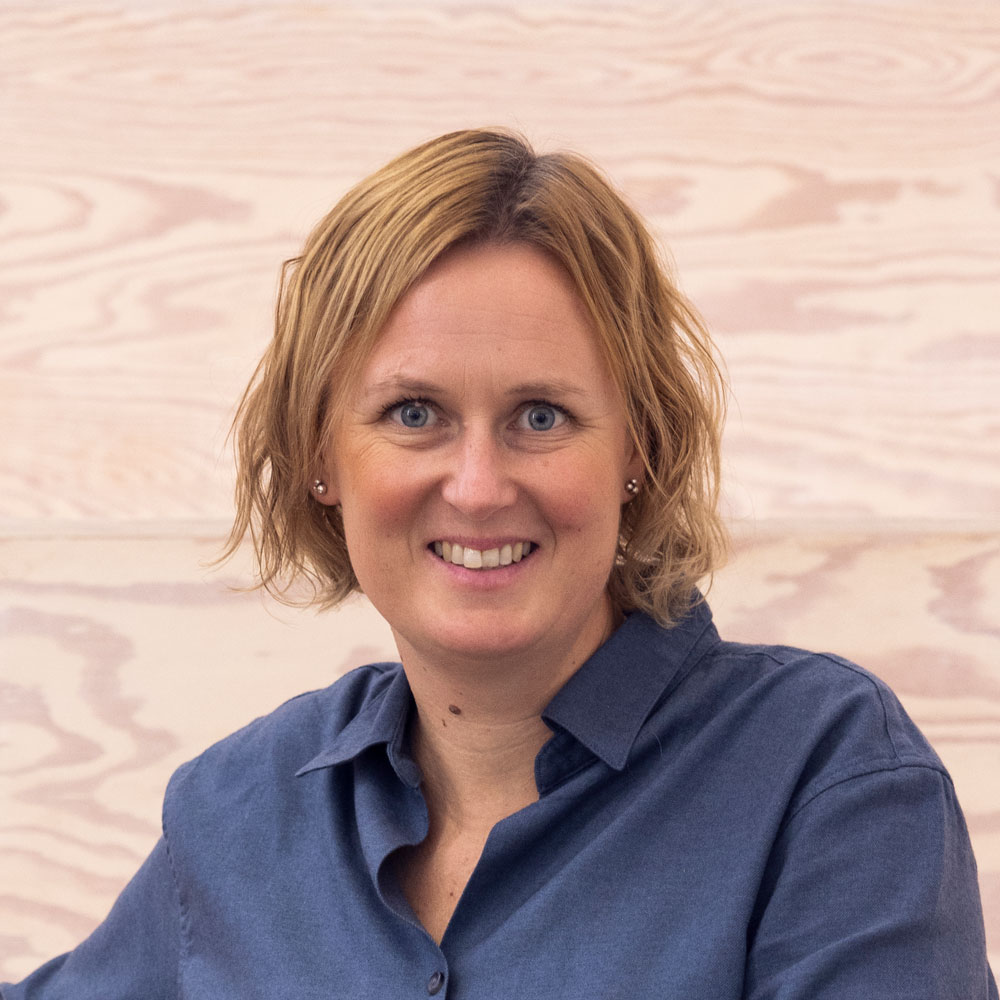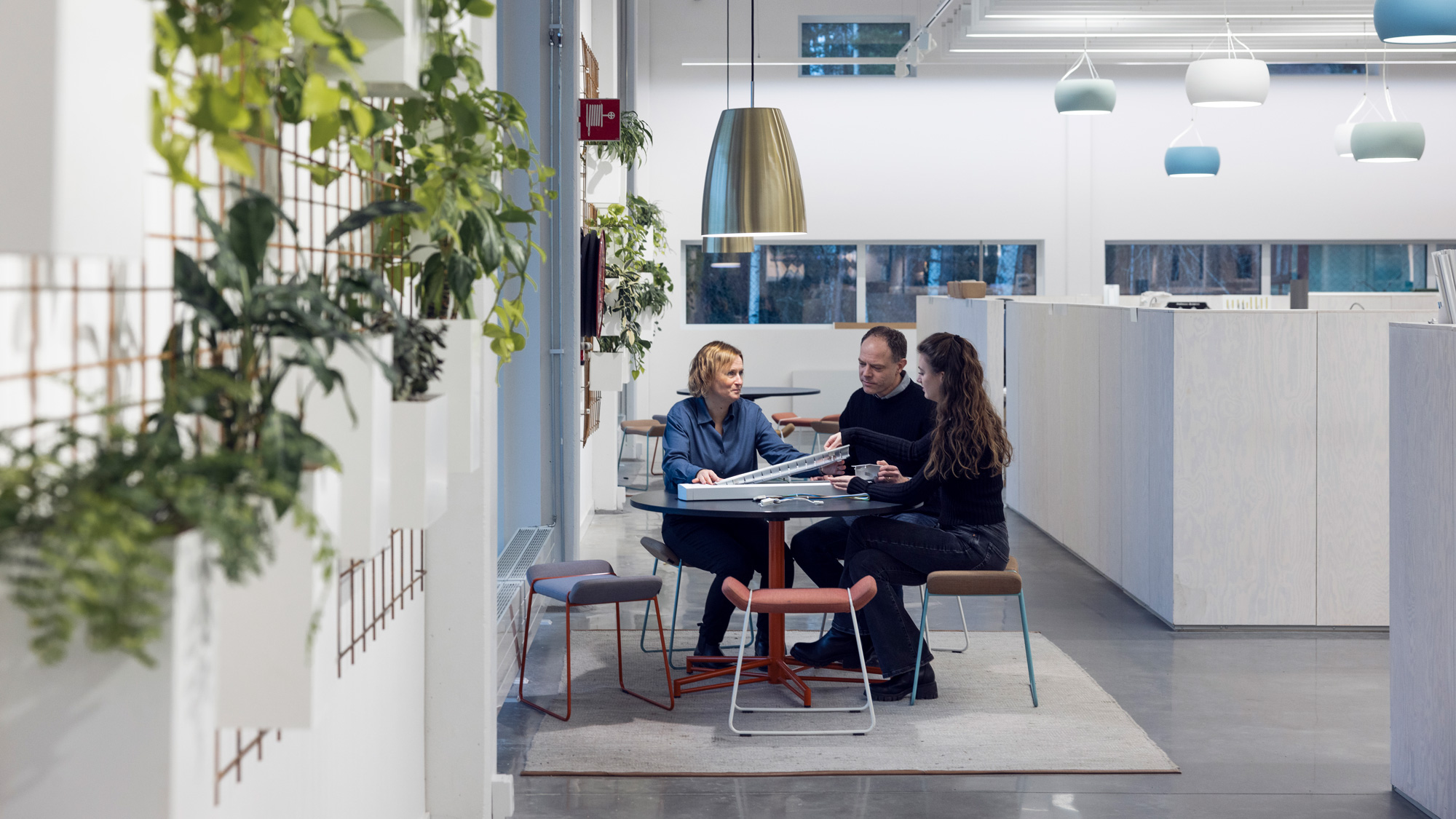
Closing the loop – and extending the lifecycle of luminaires
The concept of rebuilding old luminaires to save material and energy is growing. Sometimes, all an outdated luminaire needs to shine bright again is some tender love and engineering skills. We met Emma Hallman, Mathilda Holl and Andreas Ekslätt, the team behind ReLight at Fagerhult, to discuss the challenges of finding solutions that will take old luminaires into the future.
At Fagerhult, a deeply rooted innovation culture influences all aspects of work. Possibly, it springs from the founder Bertil Svensson's mindset of solving problems with sometimes small means – and curiosity and dedication. Unlike today, sustainability may not have been a buzzword back then. However, using our resources consciously and striving for high quality have always been cornerstones for Fagerhult. Today, a new focus on circularity has urged us to challenge our thinking and makes us conscious of finding long-lasting solutions.
Fagerhult's Bespoke Lighting Solutions (BLS) department has developed unique luminaires and adapted solutions for many years. So, refurbishing and updating old luminaires is something familiar to us. However, the ambition to reuse and rebuild old luminaires to lower climate impact has increased over time. In this process, yesterday's design and technology are brought up to speed by today's advances to meet the requirements of tomorrow.
 "We want to make reusing luminaires a more accessible choice. We have complete standard kits for many luminaires to be ordered more or less off-the-shelf. We thoroughly analyze new requests and design solutions based on our core ideas of light comfort and high quality. We are constantly refining our process, with a desire to facilitate reuse as much as possible." Emma Hallman, Business Development Manager
"We want to make reusing luminaires a more accessible choice. We have complete standard kits for many luminaires to be ordered more or less off-the-shelf. We thoroughly analyze new requests and design solutions based on our core ideas of light comfort and high quality. We are constantly refining our process, with a desire to facilitate reuse as much as possible." Emma Hallman, Business Development Manager
ReLight your old luminaires
To the ReLight team at Fagerhult, there are no unusual questions or impossible solutions. Daily, they manage inquiries regarding specially developed lighting solutions for projects from Fagerhult's markets. It's a complex process, but over time, they have learnt that some projects are ideal for reusing old luminaires instead of investing in new ones.
"To us, the luminaire's qualities in lighting comfort, safety and aesthetics are at the core of every ReLight project. When requested, we also calculate if – and how much – we can reduce the luminaire's total climate impact through its lifecycle." says Emma Hallman.
Within ReLight, there is an outspoken will to save materials and energy – and make an environmental effort by updating the luminaires. However, not all old luminaires can live forever; some are outdated and better recycled than refurbished.
"If the circumstances don't meet our requirements and it doesn't work to rebuild the luminaire, we will not take the project further. We would never compromise on light comfort, quality, safety or the expression of the luminaire if it does not result in a first-class end solution", says Emma Hallman.
At Fagerhult, safety and quality are the red threads that combine all products. And ReLight is no exception. Throughout the process, CE-marking and testing are crucial factors.
"To ensure the overall quality, the updated luminaire is CE-marked in full before delivery. We also want to make the installation on site both smooth and quick, and the new kit is as close to a complete luminaire as possible," says Andreas Ekslätt, Design Engineer.
TEXT LINDA KARLSSON
PHOTO BJÖRN CEDER

Do you want to review your lighting solution?
Do you need to update, replace or rebuild your existing lighting solution – or maybe you just want to know a little more about how ReLight project is carried out? Read more about ReLight and do not hesitate to contact your local sales office for guidance and more information.
Read moreRelated News

When material matters – Wrapped adds a new view on sustainable lighting
In a world where every gram of material and every gram of carbon dioxide counts, Wrapped emerges not just as a luminaire – but as a statement. It’s Fagerhult’s most sustainable pendant to date, and it didn’t happen by accident. Every detail, every decision, every material was chosen with intention. Sustainability often starts with a simple question: What is it made of? For Wrapped, the answer is a trio of materials that each carries its own environmental story. Solid board: a familiar friend At Fagerhult, we first met Solid board in 2021 with Multilume Re:Think. But for Wrapped, we’ve taken it further. The material consists of a three-layer construction featuring a 100% recycled core, a renewable FSC-certified top layer, and a thin protective plastic film. All in all, a material that’s 65% recycled – and a 89% reduction in CO₂ emissions compared to virgin extruded aluminium. Image gallery: Solid board Wrapped is made of organic Solid board, recycled aluminium and post-consumer recycled plastic. Reimagining plastic Plastic is often a hot topic in sustainability conversations. But not all plastic is created equal. Wrapped uses post-consumer recycled plastic: the kind that has lived a life before, perhaps as a shampoo bottle or food container. Pre-consumer plastic, on the other hand, is different as it never made it to the shelf. Quote: Josefin Carlsson Aluminium with a past Inside Wrapped, two structural components are made from 100% post-consumer recycled aluminium. This material is also part of a circular infrastructure – and may even have been part of a Notor luminaire once. Compared to virgin aluminium, this choice reduces emissions by 83%. Designing with less - built to last However, sustainability isn’t just about what you use – it’s about how much. At just 900 mm, Wrapped is shorter than a conventional 1200 mm pendant. That reduction in size alone cuts the climate impact by 25%, without compromising the luminaire’s lighting performance. Josefin Carlsson compares the climate impact of products in Fagerhult's Experience Centre in Habo. To understand the impact of Wrapped, it helps to look at where we started. In 2021, Notor 65 – made from virgin aluminium – had a climate impact of 34 kg CO₂e. By 2024, with 75% recycled aluminium, that number was reduced to 25 kg CO₂e. Today, Wrapped comes in at just around 12 kg CO₂e. “That’s a third of the original Notor 65, and half of the current version, and a quiet revolution, measured in kilograms of CO₂e,” says Josefin Carlsson. After its long life – estimated at 100,000 hours – Wrapped is ready for an equally sustainable exit. Its design makes it easy to disassemble, with each material being recyclable and prepared for its next chapter in the circular economy.
Fagerhult uses recycled aluminium for high-volume products — ensuring circular use of resources
With a focus on reducing its long-term greenhouse gas emissions, Fagerhult now choose extruded aluminium profiles containing 75% recycled material from end users. The material is used for product families manufactured and sold in larger volumes — and where the material can make a real difference. The initiative reduces Fagerhult’s climate footprint by approximately 225 tons of CO2e per year.Aluminium is a lightweight and durable material that can be reused multiple times if recycled properly. Its environmental impact depends on several factors, including whether it is made from virgin aluminium, how it is produced, whether fossil fuels or renewable energy sources were used in its production, and if it is derived from recycled materials.Niclas Thulin is Sustainability Manager at Fagerhult:“We are taking a significant step forward by moving from renewably sourced aluminium to recycled aluminium (post consumer). The Notor family – together with several other product families – is now made of extruded aluminium that is 75% recycled. This results in around 70% lower climate impact than the average impact from European primary aluminium and 88% lower than the global average for primary aluminium*.”The change affects products sold in larger volumes. The products Notor 65, Notor Recessed, Notor 36, Fjord, Vil, Multilume Hydro, and Sentra are now made of recycled aluminium.“We intentionally upgrade the materials for our larger product series because it significantly impacts Fagerhult's greenhouse gas emissions. For the Notor family alone, we used approximately 65 kilometres of aluminium profiles in 2024, and nearly all of this volume has now been replaced with recycled material,” says Niclas Thulin.The change is part of Fagerhult's systematic sustainability work and a considerable step in reducing greenhouse gas emissions in Scope 3: the company's indirect emissions from purchased materials. The Science Based Targets validate Fagerhult's climate targets, and the ambition is to achieve net zero emissions from the entire value chain by 2045.“This is our most important decision regarding materials, at least with reduced climate impact as the fundamental incentive. The majority of our emissions come from Scope 3, and through this change, we are making a difference where it has the greatest impact. Based on last year's volumes, the switch to recycled aluminium can reduce emissions by approximately 225 tons of carbon dioxide equivalents annually.”*Climate impact excluding the extrusion process. EPD compared to the European average for primary aluminium (European Aluminium) and the global average for primary aluminium (International Aluminium).
